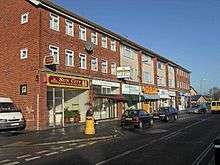Rowner
Coordinates: 50°49′19″N 1°10′34″W / 50.822°N 1.176°W


Rowner is a part of Gosport, Hampshire, mostly famous for the high rise flats which dominate the area, known as 'The Concrete Jungle'. Rowner was first mentioned in the Domesday Book, during the 11th century. In the area is a field, accessible for walkers, and a dirt track for BMX and Mountain Bike riders. Part of the 1960s Naval estate is undergoing redevelopment, as part of the Rowner Destruction Scheme, after the compulsory purchase of private homes already there.
History
At the time of Domesday Book of 1086 the manor of Rowner was held by William Mauduit.[1] The family of Mauduit seems to have been of considerable importance at this time as the possessor of large estates in Hampshire, and its members were among the chamberlains of Henry I and Henry II.[1] In the 13th century Rowner passed out of the Mauduit family, and in 1240–1 Elias de la Falaise was holding land in Rowner.[1] He died in 1254, and his brother William died in possession of the manor in the same year.[1] Before 1277 the property had escheated to the Crown by the felony of William de la Falaise, grandson of William, and was granted in that year to Sir William le Brune, chamberlain to the king.[1] The manor then stayed solidy in the Brune family until the death of Charles Brune in 1769, when the family became extinct in the male line.[1] By his will his estates eventually devolved onto his grand-nephew the Rev. Charles Prideaux-Brune of Prideaux Place, Padstow, Cornwall, and it remained in the possession of the Prideaux-Brune family into the 20th century.[1]
The medieval church of Saint Mary the Virgin is a 12th/13th century building - the oldest church in Gosport - which was extensively modified in 1874, and shows little old work outside, none of the windows having preserved their old stonework.[1] The 19th century Palmerston Forts of Fort Rowner, Fort Brockhurst, and Fort Grange, lie to the east and south.[1] According to the Anglo-Saxon Chronicle, Henry I held court in the parish in 1114 before boarding to travel to his estates in Normandy.
As the start of the 20th century there was no actual village of Rowner, only a number of old cottages scattered over a long narrow strip of land, the southern and eastern portions of which had been bought by the War Office for the land defences of Portsmouth.[1]
Notes
External links
![]() Media related to Rowner at Wikimedia Commons
Media related to Rowner at Wikimedia Commons